The Samsung SSD 830 Review
by Anand Lal Shimpi on September 24, 2011 1:02 AM EST- Posted in
- SSDs
- Storage
- Samsung
- pm830
- Samsung SSD 830
AnandTech Storage Bench 2011
Last year we introduced our AnandTech Storage Bench, a suite of benchmarks that took traces of real OS/application usage and played them back in a repeatable manner. I assembled the traces myself out of frustration with the majority of what we have today in terms of SSD benchmarks.
Although the AnandTech Storage Bench tests did a good job of characterizing SSD performance, they weren't stressful enough. All of the tests performed less than 10GB of reads/writes and typically involved only 4GB of writes specifically. That's not even enough exceed the spare area on most SSDs. Most canned SSD benchmarks don't even come close to writing a single gigabyte of data, but that doesn't mean that simply writing 4GB is acceptable.
Originally I kept the benchmarks short enough that they wouldn't be a burden to run (~30 minutes) but long enough that they were representative of what a power user might do with their system.
Not too long ago I tweeted that I had created what I referred to as the Mother of All SSD Benchmarks (MOASB). Rather than only writing 4GB of data to the drive, this benchmark writes 106.32GB. It's the load you'd put on a drive after nearly two weeks of constant usage. And it takes a *long* time to run.
1) The MOASB, officially called AnandTech Storage Bench 2011 - Heavy Workload, mainly focuses on the times when your I/O activity is the highest. There is a lot of downloading and application installing that happens during the course of this test. My thinking was that it's during application installs, file copies, downloading and multitasking with all of this that you can really notice performance differences between drives.
2) I tried to cover as many bases as possible with the software I incorporated into this test. There's a lot of photo editing in Photoshop, HTML editing in Dreamweaver, web browsing, game playing/level loading (Starcraft II & WoW are both a part of the test) as well as general use stuff (application installing, virus scanning). I included a large amount of email downloading, document creation and editing as well. To top it all off I even use Visual Studio 2008 to build Chromium during the test.
The test has 2,168,893 read operations and 1,783,447 write operations. The IO breakdown is as follows:
| AnandTech Storage Bench 2011 - Heavy Workload IO Breakdown | ||||
| IO Size | % of Total | |||
| 4KB | 28% | |||
| 16KB | 10% | |||
| 32KB | 10% | |||
| 64KB | 4% | |||
Only 42% of all operations are sequential, the rest range from pseudo to fully random (with most falling in the pseudo-random category). Average queue depth is 4.625 IOs, with 59% of operations taking place in an IO queue of 1.
Many of you have asked for a better way to really characterize performance. Simply looking at IOPS doesn't really say much. As a result I'm going to be presenting Storage Bench 2011 data in a slightly different way. We'll have performance represented as Average MB/s, with higher numbers being better. At the same time I'll be reporting how long the SSD was busy while running this test. These disk busy graphs will show you exactly how much time was shaved off by using a faster drive vs. a slower one during the course of this test. Finally, I will also break out performance into reads, writes and combined. The reason I do this is to help balance out the fact that this test is unusually write intensive, which can often hide the benefits of a drive with good read performance.
There's also a new light workload for 2011. This is a far more reasonable, typical every day use case benchmark. Lots of web browsing, photo editing (but with a greater focus on photo consumption), video playback as well as some application installs and gaming. This test isn't nearly as write intensive as the MOASB but it's still multiple times more write intensive than what we were running last year.
As always I don't believe that these two benchmarks alone are enough to characterize the performance of a drive, but hopefully along with the rest of our tests they will help provide a better idea.
The testbed for Storage Bench 2011 has changed as well. We're now using a Sandy Bridge platform with full 6Gbps support for these tests.
AnandTech Storage Bench 2011 - Heavy Workload
We'll start out by looking at average data rate throughout our new heavy workload test:

The SSD 830 manages to get within 13% of the SF-2281 based HyperX. While the old 470 couldn't really compete with the current generation of 6Gbps drives, the 830 holds its own. In the performance breakdown we see it's actually in the average read performance that the 830 falls behind. Its lackluster performance here is a bit surprising but given how well the SandForce drives perform it looks like the controller may just be getting bogged down by a bunch of IOs that SF just throws away, which in turn impacts its ability to deliver higher read performance.
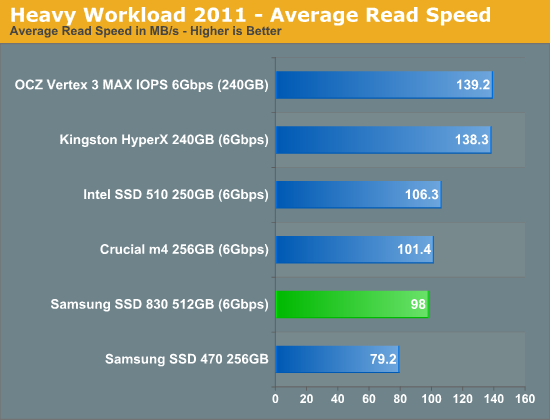
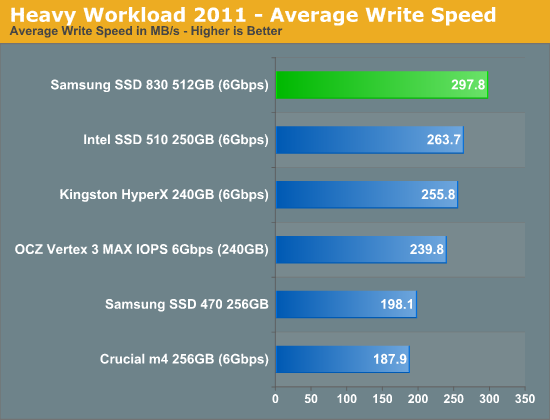
The SSD 830 actually does the best out of all of these drives when it comes to pure write speed. This isn't too surprising given how well the 830 performed in our incompressible sequential write test.
The next three charts just represent the same data, but in a different manner. Instead of looking at average data rate, we're looking at how long the disk was busy for during this entire test. Note that disk busy time excludes any and all idles, this is just how long the SSD was busy doing something:
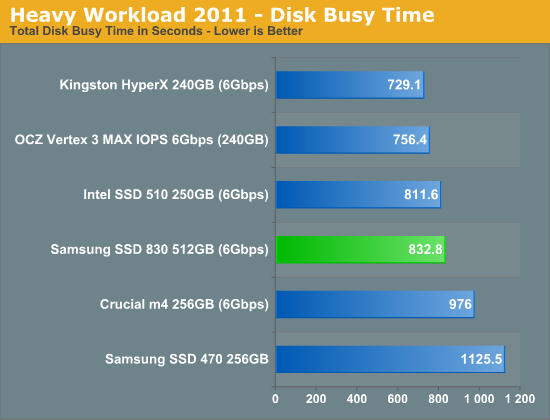
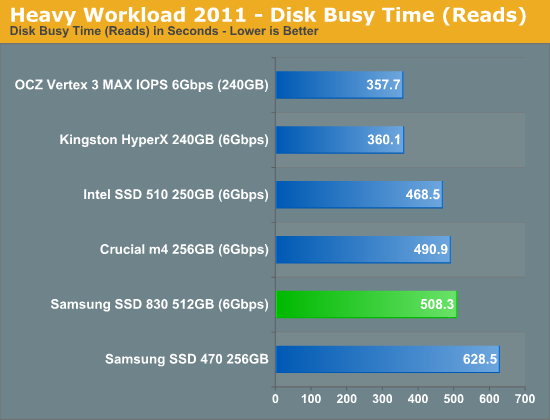
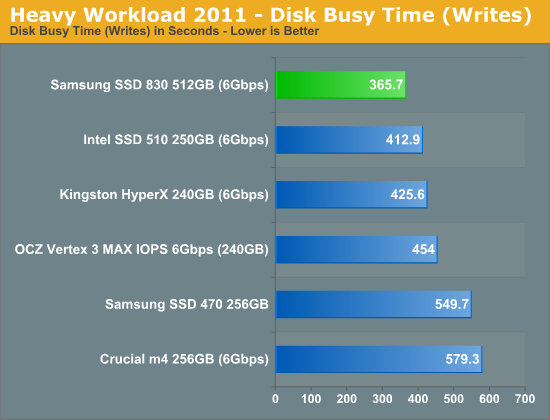










99 Comments
View All Comments
johan851 - Saturday, September 24, 2011 - link
Great article! I'm a little curious, though, as to why you prefer a drive to garbage collect in real time rather than cleaning up after the fact. While I think I sympathize with the idea of improving worst-case performance at the expense of the average, which essentially gives users a less bumpy ride, aren't most typical desktop usage scenarios full of idle disk time?I like the emphasis on Anandtech on what actually matters in real world scenarios, but it seems that your complaint on this particular matter is very much the opposite. The typical desktop user isn't going to fill the drive with writes and then immediately demand super high performance - at least I can't think of a desktop usage situation that would exhibit that pattern. I work on my computer for a few hours and then it sits for a while. Given that the average user idles their disk constantly, doesn't cleaning up while idle provide higher average performance in the long run?
Anand Lal Shimpi - Saturday, September 24, 2011 - link
You are correct, for mostly idle workloads it should work fine. The problem is with a mostly full drive, it's possible that during bursty periods of work the performance will degrade to the point that you'd notice it. Hopefully it'd correct overnight but if you sleep your machine then it prolongs the process.I'd argue that most desktop workloads won't show the difference between 150MB/s and 100MB/s in 4KB random writes. I'd much rather have the latter and enjoy a more consistent user experience.
I do understand Samsung's argument that delaying garbage collection would seem to work for mostly idle scenarios, I just don't believe there's any downside to doing it the opposite way and only potential upside there.
Take care,
Anand
johan851 - Saturday, September 24, 2011 - link
Fair enough. Thanks for the reply and another awesome SSD article.leexgx - Sunday, September 25, 2011 - link
but even worst case its still 200x faster then an HDD do same work load, you not notice it unless your benchmarking itdid the disk have any stuttering issues when it was very badly degraded? (access time was reported as 0.1 in that test)
i did not see it but do you no longer do access time tests any more
marraco - Saturday, September 24, 2011 - link
Even if the common user don't use it, is important to know.And the drive is not just for the common user.
Malih - Monday, September 26, 2011 - link
Well, enthusiast gamers usually use SSD as game installation disk, and they would (mostly) play games right away after installing or downloading from Steam.So 'on-write-garbage-collection' is preferable in this case.
Beenthere - Saturday, September 24, 2011 - link
As any number of owner reviews can attest the Samsung 470 was a nightmare of problems for many people concerning compatibility and in some cases reliability. The 830 looks to be a nice performance improvement but if the compatibility, garbage cleaning and installation/reliability issues haven't been resolved, these drives like the majority of current MLC based SSDs are simply not ready for Prime Time. Samsung's customer support appears non-existent. Consumers are being used as unpaid Beta testers IMO.kmmatney - Saturday, September 24, 2011 - link
I've had no problem with my Samsung 470 - I can attest that its a reliable drive.xype - Saturday, September 24, 2011 - link
I have a 470 that I installed in my 2009 MacBook Pro. Works like a charm, installation happened without problems, seems reliable (so far). *shrugs*jwilliams4200 - Saturday, September 24, 2011 - link
He wrote "any number" of reviews. Zero is a number.